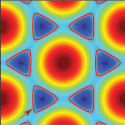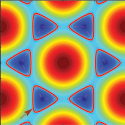Scarred graphene
In the same way that scarring is a lingering reminder, quantum scarring harkens back to the classical world in a quantum scenario. Quantum scarring occurs in a quantum system that becomes chaotic in the classical limit and the “scars” are wave functions that gather around those classical paths that retrace themselves. This is perhaps counterintuitive, as one expects quantum wave functions to eschew the predictability of classical orbits.
Writing in Physical Review Letters, Liang Huang and colleagues at the Arizona State University, US, go a step further and ask if we should be able to see scarring in a relativistic quantum scenario, that is, one described by the Dirac, rather than the Schrödinger, equation. They consider this problem specifically in graphene, which has been called the prototypical bench-top relativistic quantum system. Due to its peculiar band structure, the charge carriers in graphene behave as relativistic particles with zero effective mass.
Huang et al. use a tight-binding calculation to study a confined geometry (a stadium-shaped quantum dot encompassing over 10,000 carbon atoms) both near and far from the relativistic limit, and under various confinement scenarios, and “see” the telltale imagery of scarring. This study should be tantalizing to researchers in both condensed matter transport as well as nonlinear dynamics. – Sami Mitra





